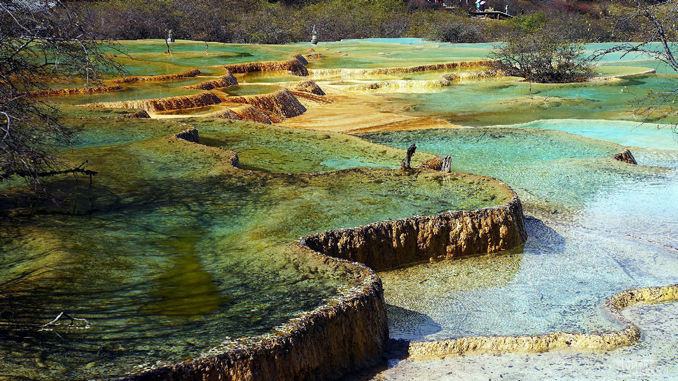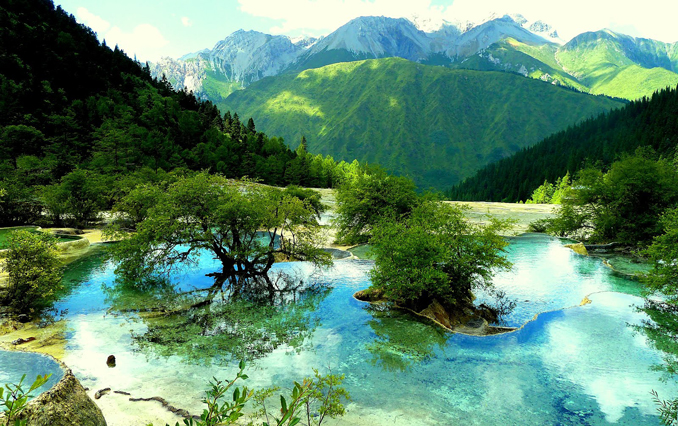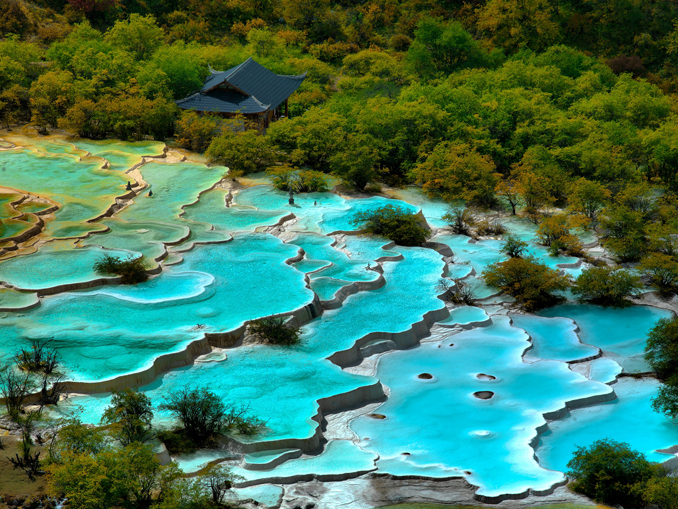Written by: Feng Yang
Posted on: February 04, 2015 | 
Huanglong Nature Reserve or Yellow Dragon, China
Huanglong, or the "Yellow Dragon", is a nature reserve and scenic spot on the plateau of northwestern Sichuan Province, in southwest China. It features snow-capped mountains as magnificent as those in Canada, primitive forests as beautiful as those of Colorado, United States, and a canyon as picturesque as that of Wyoming. The travertine pools match those in Yellow Stone National Park. A mountain separates Huanglong from the Jiuzhaigou, which is also a famous scenic spot. In order to reach Huanglong area from Jiuzhaigou area, one has to travel well over 100 kilometers along a highway that winds up and down the mountains.
Huanglong Nature Reserve covers 700 square kilometers. On average, it rises from 1,700 to 5,000 meters above sea level. The peak, which stands 5,588 meters above sea level, is covered with snow all year round.
Travertine formations form the most unique and salient feature of this Nature Reserve
 |
Over thousands of years, water from melted snow and surface water have combined to form currents flowing beneath porous limestone, and in the process, calcium carbonate substances in rocks are dissolved in those undercurrents. Occasionally such undercurrents emerged from underground. As these currents flowed, calcium carbonate carried in the water, crystallized and stuck to rocks, grass and even feathers in their way. Travertine formations were created as a result, due to factors such as water temperature and declining atmospheric pressure.
The rolling terrain at Huanglong area helped form travertine of various shapes – travertine pools, shoals and waterfalls, due to which the area is known as a "natural travertine museum". Travertine landscapes are mostly found in the Huanglong area, Zhaduo and the Er'daohai gullies, 3,000-3,600 meters above sea level. What merits special mention is that the travertine landscapes in these gullies are in different stages of evolution – some are still in the making, some are degenerating, and others have degenerated. That's why it doesn't take much time for visitors to learn the entire process of travertine evolution.
The Yellow Dragon Gully is where travertine landscapes are most concentrated. It is seven kilometers long and up to two kilometers wide. Travertine formations in the gully are 3,600 meters long. Moreover, they are naturally arranged in such a way as to look like a Chinese dragon, hence the gully's name of "Yellow Dragon".
 |
About 3,400 travertine pools of various sizes and shapes are found at different heights in the gully. The pools look like pearls that have been strung up. There are eight groups of pools. Some pools are several hundred square meters large, and there are also pools as small as a straw hat. Some are round or fan-shaped, and still others resemble lotus seedpods or flowers. The beds and sides of the pools are creamy or light-yellow in color, but the pools appear colorful due to the deposited substances on their beds and reflections of the surrounding mountains, trees and clouds. Scooping up water with your cupped hands, you will find the water crystal-clean and refreshing. All this makes the gully a fairyland on earth.
The largest group of colorful pools is called the Five-Color Pools, situated at 3,500 meters above sea level. In an area of 21,000 square meters, 683 colorful pools are counted. The water in the pools is very shallow, gently brimming from one pool to another. From afar, the pools look like jade plates. The word "colorful" is clearly insufficient to describe the beauty of the gully, especially in winter, when the gully is covered with snow and all is white – the trees, the mountains and the frozen water falls.
In the middle of the Huanglong Gully, there is a 1,300-meter long travertine shoal, its narrowest section measuring 40 meters and the widest 122 meters. There is a kind of ridge-like slope where it is difficult for calcium carbonate substances to accumulate, settle and form pools. Hence the water flows down, rushing all over the slope, and, as a result, calcium carbonate sticks to the surface of the slope and forms a shoal covered by layers of calcium that resemble fish scales. The Golden color is predominant, embedded with shades of creamy white, gray and dark green. Getting atop the slope and overlooking the gully, one sees a golden outstretching ridge covered by Calcium Carbonate scales and washed by gently moving water, looking like a huge “golden dragon”. Geologists say that this is the largest, best preserved, longest, and the most colorful surface travertine shoal in the world.
 |
The gully also has the world's longest collapse travertine structure – a cliff on the second terrace of the gully. Travertine deposits falling down from the "golden dragon" abruptly collapse here and form a light yellow cliff, 10 meters high and 40 meters wide. The thick travertine layer on the cliff surface looks like a curtain or waterfall.
Travertine waterfalls are occasionally seen in the gully. Upon stepping into the gully and passing the first colorful pool group, one sees water flowing down from the shoulder of the stone wall that stands 10 meters high and 60 meters long. The terraced terrain divides the waterfall into dozens of smaller falls, with some looking like pearls, falling apart from a broken pearl string. The cliff behind the waterfalls is covered by a lung-shaped travertine, with a looming golden tone. All this combines to make the waterfall magnificent and beautiful.
The Zhaga Waterfall, located in the primitive forests in the Zhaga Gully, is 93 meters high and 35-40 meters wide. This waterfall features the longest vertical drop in the country and is also the highest travertine waterfall – 3,176 to 3,270 meters above sea level.
Plants grow sparsely amidst the colorful pools, waterfalls and shoals washed over by shallow water. The plants are either above the water surface or submerged underwater. The travertine pieces formed by Calcium Carbonate substance deposited on the trunks, boughs, stalks and leaves look like strange rocks or willow trees, all suggestive of Chinese artificial rockery. The most representative is the Rockery Pool area, covering 20,000 square meters. There are 330 smaller pools grouped together, with some pools inside others, and overgrown with bushes and flowers. This presents a dazzling array of artificial rockery of various sizes and shapes.
You may also like: